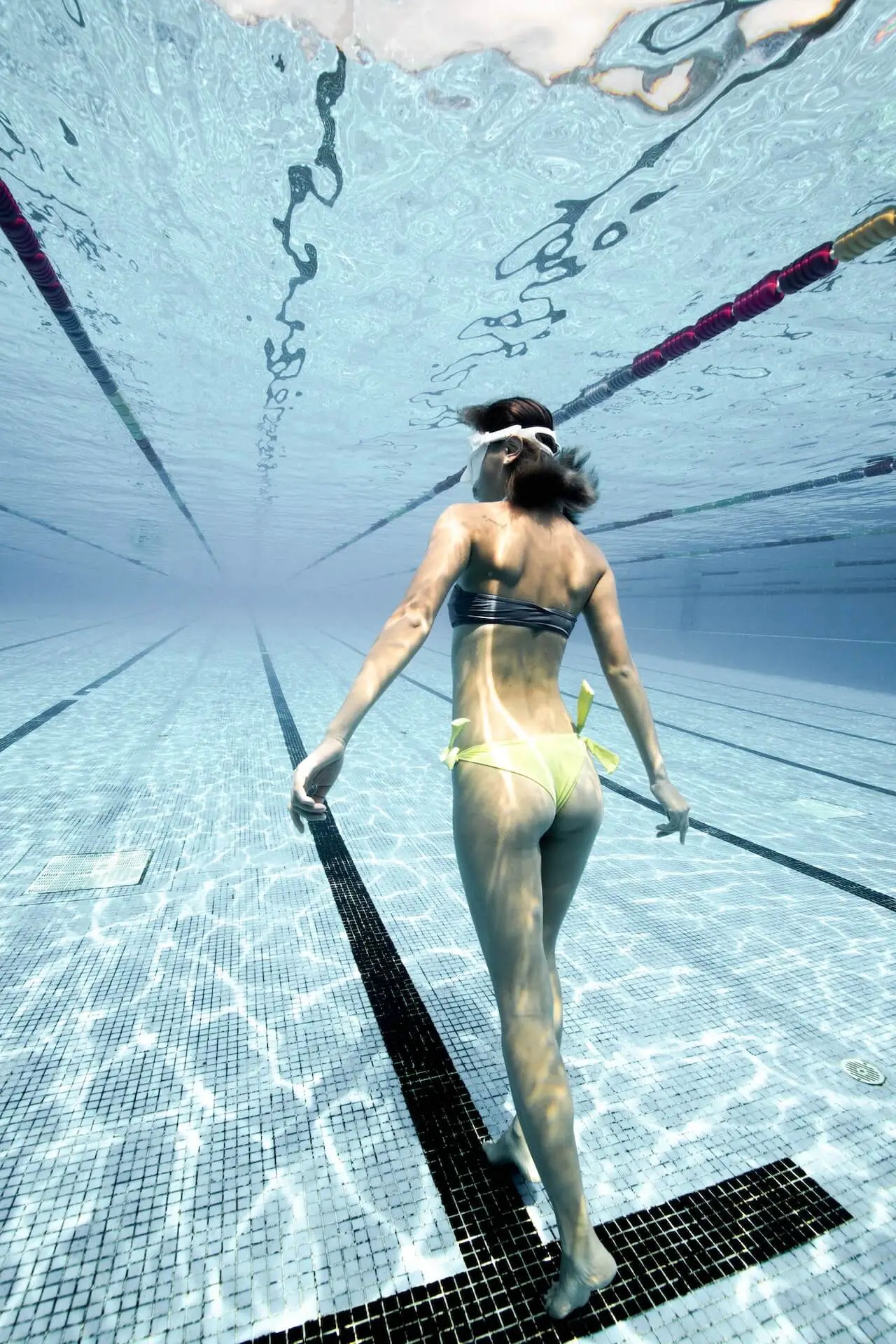Do you ever feel like you struggle to stay afloat while swimming? What you are fighting against is negative buoyancy. But just because you are negatively buoyant doesn’t mean you have to give up swimming.
Yes, you can swim with negative buoyancy. Depending on your body composition, particularly if you’re lean, you may not be able to stay afloat without expending energy. However, with proper swimming technique, you can conserve energy and swim for a long enough time to get a good workout in. Otherwise, you should rely on a buoyancy aid to stay afloat.

In this article, we’ll explore the concept of negative buoyancy, what causes it, and how you can overcome it to enjoy time in the water.
Swimming with Negative Buoyancy
Feasibility of Swimming with Negative Buoyancy
Swimming with negative buoyancy is possible, although it can be more challenging than swimming with neutral or positive buoyancy.
When you experience negative buoyancy, it means your body is denser than the water you’re immersed in, making it more difficult to stay afloat and maintain an ideal body position for swimming.
To swim more effectively with negative buoyancy, focus on improving your body position and kicking technique. Keep your body as flat and streamlined as possible – this reduces the resistance you encounter while swimming. Maintaining a strong, consistent kick will also help propel you forward and counteract the downward force caused by negative buoyancy.
In addition, you could try wearing a buoyancy control device or adding extra buoyant equipment to help you achieve a more neutral buoyancy. This can make swimming with negative buoyancy more comfortable and manageable.
Negative Buoyancy in Scuba Diving
For scuba divers, managing buoyancy is crucial, and negative buoyancy can have both advantages and disadvantages. While diving, there are three main states of buoyancy – positive, negative, and neutral.
Positive buoyancy is when your body is more buoyant than water, causing you to float. This generally occurs at the surface and is helpful during surface swims.
Negative buoyancy means your body is denser than water, which can be helpful when you want to stay at a certain depth in the water column. Scuba divers must find a balance between remaining negatively buoyant enough to descend and maintain their depth while still being able to adjust their position and move efficiently through the water.
Neutral buoyancy is the ideal state for scuba divers, allowing them to hover effortlessly at any depth. Divers achieve this through proper weighting, adjusting their buoyancy control device (BCD), and breath control.
Scuba divers will adjust between these three buoyancy states as needed using their BCD.
How to Overcome Negative Buoyancy
There are several training programs and exercises that can help improve your swimming abilities when dealing with negative buoyancy. These may include:
- Buoyancy control exercises: Practice holding your breath and regulating buoyancy to move your body up and down in the water. This will help you better understand how your body reacts to changes in water depth and pressure.
- Strength and flexibility training: Focus on exercises that improve your upper body strength and flexibility. These will enable you to maintain proper swimming posture and balance while submerged.
- Swim technique drills: Practicing various swim strokes and techniques can help you find the most efficient way to move through the water while negatively buoyant. Some of these techniques may include the front crawl, breaststroke, or butterfly.
- Underwater navigation: If you plan on diving while negatively buoyant, you’ll need to familiarize yourself with underwater navigation techniques. This will help you maintain orientation and direction when descending to different depths.
Incorporate these exercises and training programs into your regular workout routine, and you’ll see improvements in your ability to swim with negative buoyancy over time.
Risks and Precautions

Potential Dangers of Negative Buoyancy Swimming
There are a few risks associated with negative buoyancy swimming that you should be wary of:
- Risk of drowning: The primary concern is the risk of drowning, especially if you panic and fail to reach the surface or swim back up.
- Increased fatigue: Fighting negative buoyancy can lead to extra physical strain. Overexerting yourself may result in exhaustion and further difficulties staying afloat.
- Decreased visibility: Swimming deeper due to negative buoyancy can lead to reduced visibility, making it harder for others to notice you needing assistance.
Safety Precautions
To minimize the risks associated with negative buoyancy swimming, follow these safety precautions:
- Practice buoyancy control: Develop your ability to maintain a horizontal position while swimming. This will help you stay afloat and move through the water more efficiently.
- Wear appropriate gear: If you’re scuba diving, a buoyancy compensator device (BCD) can help control your buoyancy in the water. For other sports, consider wearing a snorkel vest, life vest, or wetsuit to provide additional buoyancy. Additionally, a brightly colored swim cap or swim belt can make it easier for others to spot you.
- Take breaks: Regularly check your energy levels and take breaks to rest and recover when needed, and don’t swim too far from a boat, the shore, or the walls of a pool.
Frequently Asked Questions
What factors contribute to human negative buoyancy?
Negative buoyancy in humans is primarily due to the differences in body composition, such as muscle mass, fat percentage, and bone density. The denser the body, the more likely it will sink rather than float. Additionally, water salinity plays a significant role in determining buoyancy. In water with higher salinity, such as the Dead Sea, it is nearly impossible for a human to sink due to the increased buoyancy provided by the salt content.
How does body composition affect buoyancy during swimming?
Body composition greatly affects buoyancy when swimming. A person with a higher percentage of body fat is generally more buoyant because fat is less dense than water, whereas those with more muscle mass and denser bones tend to be less buoyant. This means that individuals with higher muscle mass and/or low body fat may find it more difficult to stay afloat while swimming than those with a higher fat percentage.
How can you overcome negative buoyancy while swimming?
To overcome negative buoyancy while swimming, one must use proper techniques and equipment, such as a buoyancy compensator or a wetsuit, which can help provide extra flotation. Additionally, practicing efficient swimming strokes and maintaining a horizontal body position allows you to glide through the water with minimal resistance.
What is the effect of bone density on buoyancy?
Bone density plays a role in buoyancy as denser bones add to the overall body density, making it harder for the person to float in the water. Note that while bone density is influenced by several factors, including age and genetics, it is not the sole determining factor of one’s buoyancy in water.
At what depth can negative buoyancy become dangerous?
Negative buoyancy itself isn’t necessarily dangerous, but it can make managing depth more challenging for divers and swimmers. In general, as you descend deeper in the water column, the risks associated with increasing pressure, such as decompression sickness, become more prevalent. Good buoyancy control is vital for divers to avoid these risks while maintaining a safe and enjoyable experience.
How do you train for better buoyancy control while diving?
To improve your buoyancy control while diving, it is essential to practice and develop efficient swimming techniques, proper weighting, and use of your buoyancy compensator. Attending a buoyancy control course with a qualified instructor or joining a dive club for guided experience can help you enhance your skills. Additionally, remember that practice makes perfect – the more you dive, the more accustomed you will become to managing your buoyancy effectively.
Sources:
- https://www.khanacademy.org/science/physics/fluids/buoyant-force-and-archimedes-principle/a/buoyant-force-and-archimedes-principle-article
- https://beginnertriathlete.com/cms/article-detail.asp?articleid=2641
- https://weswim.club/swimming-technique-tip-buoyancy/
- https://www.ncbi.nlm.nih.gov/books/NBK470245/

